#lake ecology
Text



#lilly pads#lake#ecology#does anyone known what plant those underwater ones are?!#lake ecology#aquatic#aquatic plants#plants#nature#earth#photography#my photos#flora photography#flora
1 note
·
View note
Text




Lake Ecology
October 8, 2023
Kenneth F. Burns Memorial Bridge
Worcester, Massachusetts
#massachusetts#worcester ma#lake quinsigamond#ecology#informational sign#earth science#lake ecology#our adventures
0 notes
Text

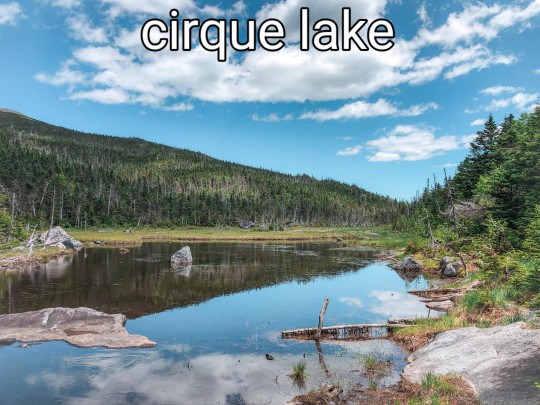
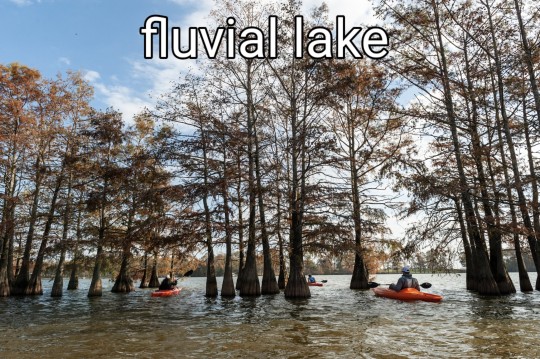

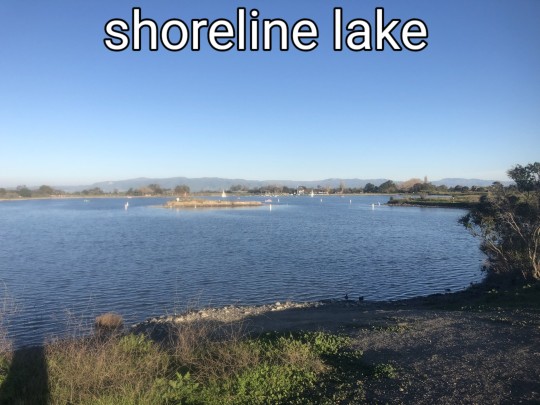
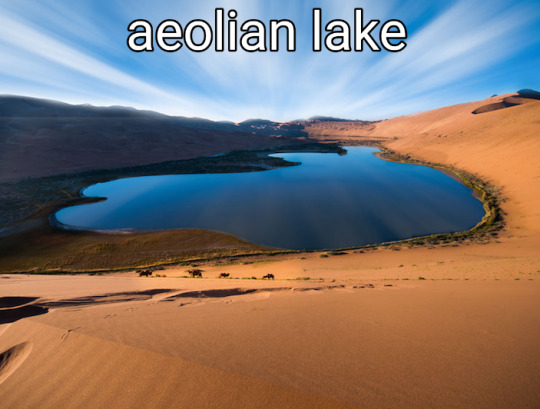




#lakes#lakeposting#poll#geology#geomorphology#nature#lake#naturecore#beautiful#limnology#science#ecology#aquatic ecology#water#meteor#meteorite#volcanic#glacier#glacial#tectonic#earth#environment#environmental science
2K notes
·
View notes
Text



A Dive into the Diving Spider
The diving spider, or water spider (Argyroneta aquatica) is perhaps one of the most unique arachnid species on Earth, noted for living almost entire life completely underwater. This species is found throughout northern Europe and Asia in clear freshwater ponds, lakes, wetlands, and slow-moving rivers with lots of aquatic vegetation.
Like other spiders, the water spider does breathe air. When submerged, specialized hydrophobic hairs create an air bubble attached to its abdomen, which allows the spider to store oxygen while moving around underwater. In addition, these spiders build a web known as diving-bell webs. These webs, constructed of spider silk, are constructed underwater, and supplied with air bubbles from the surface. A. aquatica spends most of its time in these webs, leaving only to replenish its air supply-- about once every 24 hours-- or to find prey.
The diving bell spider's prey are, unsurprisingly, primarily insects. In particular they feed on water fleas, aquatic isopods, insect larvae, and small crustaceans like shrimp. Individuals catch their prey by hiding inside their webs until prey trips one of the trip-wires constructed in the surrounding vegetation. They then surge out, seize their prey, and drag it back into the air-filled web where the spider can digest it. Predators of water spiders include aquatic beetles, dragonfly larvae, and frogs. Fish can also predate upon water spiders, but they are usually scarce due to the low aquatic oxygen environment in which the spiders live.
Ordinarily, A. aquatica is a fairly plain, brown spider. Males are slightly larger than females; 18.7 mm (0.74 in) to their 13.1 mm (0.51 in) in length; this is a rare phenomenon in spiders, as females are typically larger. Males also have a longer pair of front legs. However, females were found to construct much larger nests, as they must also provide space for their eggs and young.
When a male is ready to mate, which occurs during spring, he will construct several sperm packages that he holds in his palps, or mouth appendages, while he seeks out potential mates. If he finds a receptive mate, the two will engage in a swimming ritual around her web before he gives her one of his sperm packages. Afterwards, the female constructs a sac with 50-100 eggs; she may do this up to 6 times throughout a single year. The eggs hatch 3-4 weeks after laying, and the offspring remain in the nest for another 2-4 weeks. Individuals typically become sexually mature not long after, and may live up to 2 years in the wild.
The water spider can deliver a painful bite, with symptoms of inflammation, vomiting, and fever lasting 5-10 days. However, the bite is not known to be fatal to humans.
Conservation status: The diving bell spider has not been evaluated by the IUCN. The primary threat is likely habitat destruction, although at least one area in South Korea has been designated specifically as protected habitat for the species.
Want to request an uncharismatic critter? Just send me proof of donation to any of these vetted fundraisers for Palestinian refugees!
Photos
Stephan Hetz
#water spider#diving bell spider#Araneae#Dictynidae#spiders#arachnids#arthropods#invertebrates#freshwater fauna#freshwater arthropods#freshwater invertebrates#lakes#lake arthropods#lake invertebrates#wetlands#wetland arthropods#wetland invertebrates#europe#asia#northern europe#northern asia#animal facts#biology#zoology#ecology
167 notes
·
View notes
Text
Restoring Sturgeon to Michigan Waters
On Saturday the Grand Traverse Band of Ottawa and Chippewa Indians held their first annual Sturgeon Release Ceremony to return Nmé (Lake Sturgeon) into the Boardman-Ottaway River.
via Leelanau.com…
On Saturday the Grand Traverse Band of Ottawa and Chippewa Indians held their first annual Sturgeon Release Ceremony to return Nmé (Lake Sturgeon) into the Boardman-Ottaway River. The event included a ceremony, prayers, food, drinks, and a community release of hundreds of juvenile Nmé. The photo shows Percy Bird releasing a young sturgeon into the Boardman-Ottaway.
Michigan…

View On WordPress
127 notes
·
View notes
Text
Isle Royale, Michigan, USA. Largest island in Lake Superior in the North American Great Lakes.






#nature#hiking#summer#travel#naturecore#naturelovers#walking in nature#nature photography#trees and forests#boreal forest#great lakes#isle royale#michigan#midwest#usa#america#north america#lake superior#islands#moose#freshwater ecology#sunset#kayaking#landscape#cottagecore
84 notes
·
View notes
Text
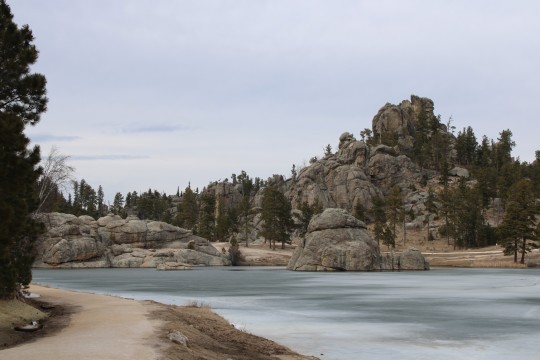

Sylvan lake, Custer State Park, South Dakota.
#sylvan lake#custer state park#south dakota#mine#nature#naturalist#nature photography#photography#ecology#north america#scenery#landscape photography#landscape#lake#geology#state parks
103 notes
·
View notes
Text

The lake Aral is disappearing - Aral, 2022
#picofthenight#travel#uzbekistan#original photographers#photographers on tumblr#nature#landscape#landscape photography#lake#ecological disaster#nature photography#photoofthenight
35 notes
·
View notes
Text

#photography#explore#nature#science#adorable#education#lol#ecology#amazing#awesome#france#lake#grand-est#camping#tuilerie#moselle#summer#landscape#water#reflection#mirror#image#trees#sky#blue#beauty#beautiful nature#beauties#beautiful
20 notes
·
View notes
Text
Regarding this post going around:

Recommend checking out an article by Kasey Keeler and Ryan Hellenbrand, published at Edge Effects in 2021, which, aside from addressing the Ojibwe story about the Nanabozho fighting against logging, also describes the origin of Paul Bunyan as an icon of clear-cutting timber industry and, later, as a symbol of the advent of the US federal government’s “German-style” forestry management.
Some quick tidbits from their article:
- References to Bunyan appear in local print media from the 1890s onward, but Bunyan became more widely known in 1916 after a scholarly publication about the folklore. In the same year, 1916, an important mass media pictorial representation was made in a promotional pamphlet by the marketing team of a major logging company as a move to give them a folksly and “local” charm as the corporation expanded from Minnesota to California.
- That same logging company had owned the land that would become both Paul Bunyan State Forest and Chippewa National Forest.
- The first national forest created by act of Congress rather than presidential proclamation was actually Chippewa National Forest, which has been described as “a laboratory” to solve “the Indian problem” and discipline/contain Ojibwe people.
- Paul Bunyan was a sort of icon of German folklore in the region. Ironically, even though Bunyan was originally associated with clear-cutting, it would in fact be "German-style” forestry policy that (in Minnesota and later across the US) replaced the original clear-cutting industrial extraction methods with a "modern" and "sustainable" management approach meant for "sustained yield" (which still just treats forests as a resource to be extracted for profit).
---
Anyway, some images, captions, and text from the article [all text below is excerpted from the article]:
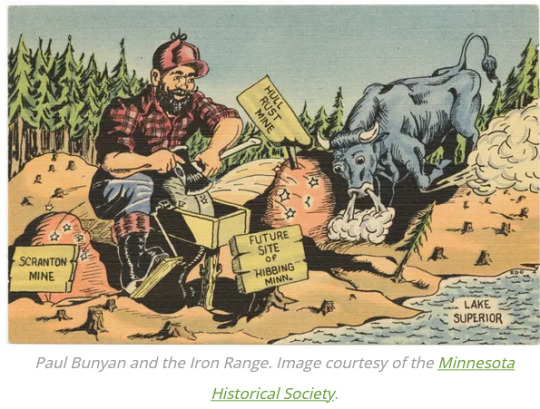
Across the Northwoods, a geography that spans the U.S.-Canada border, stories are used to make and claim space. [...] Throughout northern Minnesota, legends of Paul Bunyan, the fictional giant lumberjack, have been used to claim space. [...] Bunyan has been credited with creating Minnesota’s 10,000 lakes, the Mississippi River, and the Grand Canyon, while simultaneously logging millions of acres of forest. [...] Together, we juxtapose the history of two forests -- the Paul Bunyan State Forest and the Chippewa National Forest -- to reveal how German settlement, logging, and forestry have contributed to placemaking narratives, and how [...] nostalgia links past and present. Paul Bunyan’s literal and figurative imaginings advance American Indian erasure narratives, leading to the invisibility of these same communities today. [...] The Northwoods have been popularized and imagined as America’s version of northern Europe. [...] Across Minnesota, towns like New Ulm, New Munich, Heidelberg, and Luxemburg bear witness [...]. More recently, Native scholars Michael Dockry and Christopher Caldwell have examined [...] “the Menominee people’s profound sense of place and their intimate relationship with place.” [...]
---
Ojibwe dispossession, well underway by the late nineteenth century, is not told in any Paul Bunyan story. [...] The "heroic labor" of logging formed a significant portion of Great Lakes region economies [...] on the heels of, and entangled with, Ojibwe dispossession. [...] Formally established in 1908, the 1.6-million-acre Chippewa National Forest (CNF) lies nearly contiguous with the Leech Lake Reservation. [...] [T]he CNF was the first national forest created "for the benefit of [American] Indian people." [...] In 1902 came the Morris Act. Authored by [a] Duluth congressman [...], the act "created the first forest reserve established by congressional action rather than presidential proclamation." The act established the 225,000-acre Minnesota Forest Reserve as a “compromise,” a way to tackle the “Indian problem” while allowing for timber harvest. Here, Ojibwe homelands became “a laboratory for the first comprehensive forest management plans undertaken by a federal agency.” In 1928, the forest was renamed the Chippewa National Forest, as it remains today.
---
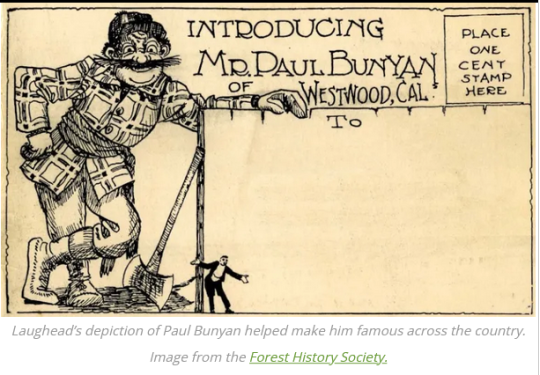
While the Chippewa National Forest forces us to consider the many ways logging and forestry has usurped American Indian peoples’ access to land, the nearby Paul Bunyan State Forest encapsulates the material legacy of symbolic myth. [...]
Officially recognized in 1935, the Paul Bunyan State Forest evolved from the site of the Red River Lumber Company sawmill. Founded in 1884, the Red River Lumber Company (RRLC) directly participated in and contributed to Ojibwe dispossession. By the end of the nineteenth century, he RRLC had purchased most of the land that comprises the present-day Pual Bunyan State Forest, milling millions of board feet of lumber at the company town of Akeley. [...]
The expansion of RRLC to California precipitated another key move: using Paul Bunyan in their marketing. William B. Laughead (pronounced Log-head), advertising manager in 1914 and a logger himself, spun another Paul Bunyan tale for the promotional booklet “Introducing Mr. Paul Bunyan of Westwood, Cal,” which included Bunyan’s first pictorial representation. This marketing campaign relied on the new and growing nostalgia for the grand logging days in the Great Lakes to keep the transcontinental corporation rooted in place.

With logging long established throughout the Great Lakes region, the ecological damage was clear. To remedy this, in the mid-1930s (German) forestry was introduced to manage timber on a sustained yield base. This, then, is the irony of the Paul Bunyan State Forest: named for an American legends who is said to have literally cleared the path for settlement, forest management now proposes to maintain the integrity of the forest. [...]
Though Paul Bunyan narratives dominate the landscape of the Northwoods, if we look closely we can see the ways Native people resist the legendary exploits. Indeed, a lesser-known Ojibwe oral story reminds us that the Anishinaabe people, their culture, and their histories will always prevail over dispossession and logging. In the story, Nanabozho, an Ojibwe trickster or cultural figure, confronts Paul Bunyan, who had already logged off most of the northeastern states before making his way to Minnesota. Nanabozho tells Paul to leave, to not log any more timber. A fight ensues, and [...] Nanabozho swings a Red Lake walleye at Paul, knocking him off his feet. As Paul stumbles, Nanabozho pulls at Paul’s whiskers, making him promise to leave the area. This is why, today, Paul Bunyan does not have a beard and why he is facing west at the statue on Lake Bemidji, as he prepares to leave the region.
This is also why we have the Chippewa National Forest, because Nanabozho and his Ojibwe kinsmen saved it from being logged. It is this contemporary narrative that highlights the complexity of Ojibwe storytelling [...].
---
Images, captions, and text as published by: Kasey Keeler and Ryan Hellenbrand. “Paul Bunyan and Settler Nostalgia in the Northwoods.” Edge Effects. 2 December 2021. [Bold emphasis and some paragraph breaks added by me.]
#abolition#ecology#indigenous#great lakes#imperial#colonial#ojibwe#victorian and edwardian popular culture#tidalectics#imperial forestry#multispecies#interspecies#geographic imaginaries
383 notes
·
View notes
Note

I made this last year (just before the creation of this blog, actually!) and it's taken me until now to actually show anyone
i believe u posted this before, actually
but fuck it, lets bring this back
#better bones au#girl idk shit abt ecology beyond the basics i just like it when the cats build their own culture#its the huge expanses on clan life that drew me to this AU anyways... it seems life in the clans seem DESIRABLE now#not to mention we can do fun shit like kitty movie night (watching the deer fight)#clan bbq... groupwide gaming sessions... pool party (at the lake). skyclan parties after successful raids... sunbaths with the bros...#nuances in language and evolving of different ideals and relationships with gender and societal roles...#THATS MY SHIT!!
12 notes
·
View notes
Text
I recently went to Temperance River State Park in Minnesota for a camping trip and figured I'd share some photos and cool facts with Tumblr about it.



The river itself! The surrounding cliff sides are a fantastic example of the eroding power of flowing water over rock when given a long enough time to work. The water would pool into "bowls" in the rock that developed as water formed pools that would develop a whirl whose force and movement would erode the bowl making it larger. Once they eroded enough the river would continue down the cliff. You could see these bowls all through the river and in the above pictures!


The water was fairly murky and had a mild sheen as well as formed bubbles throughout. This is because this far north the water flowing south into Lake Superior (which Temperance does) will have water flowing into it from bogs. About 20 miles (32.2 km) is the Cascade River and its state park named after itself which also flows with the same coloration and foam and drawing from some of the same bog lands. Minnesota's north eastern third is a coniferous forest biome and the decay of pine needles and other plants that grow in the region lower the pH in the wetlands of the region around them, which is how the bogs develop. Scotland's peet bogs are developed in the same way.
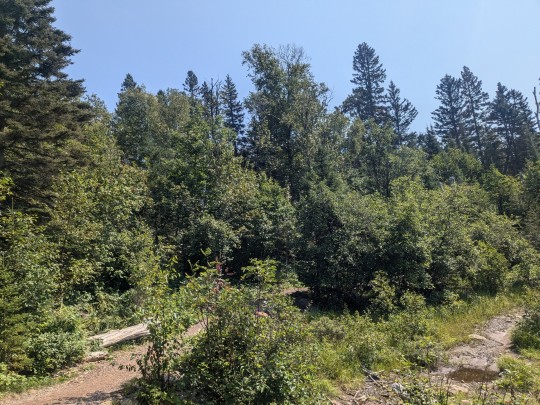
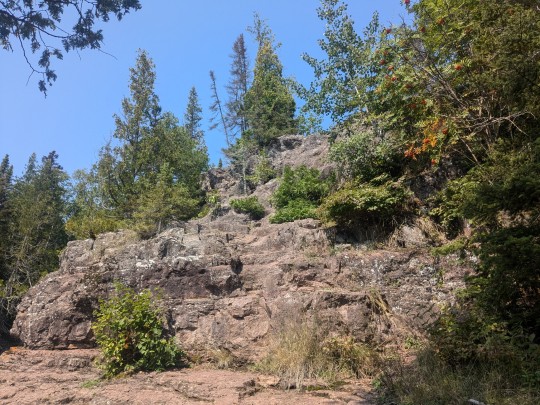
These conifers have adapted to grow into the rock faces of the area as well. The rocky region is partially due to a volcanic history in the region meeting ice age glaciers. Glaciers that largely made Minnesota as ecologically and geologically fascinating as it is. The melting of the glaciers here started the process by which this, and many over rivers and lakes here formed. As they melted the flowing water formed the divots in the ground that the future rivers would later carve their paths deeper into. You can still see those layers in the rocks in the above image.
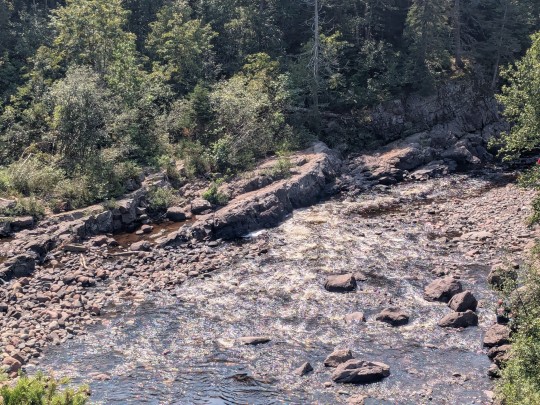
I saved my most gorgeous image for last. A lot of this information came from local signage but also from my long history of learning about the ecological minutiae of my home through interest and study. I know not everyone can make it to places like these so I hope this slice of my adventure could bring you even a sliver of the joy it brought me a marvel at it in the context of my love for nature.
#nature#state park#minnesota#Minnesota state park#temperance state park#ecology#nature photography#camping#nature education#ecology education#nature facts#ecology facts#minnesota facts#cook county#temprance river#bog facts#bogs#rivers#river facts#if this post gets like 100 notes ill post more nature stuff but thatll never happen.#great lakes#North shore#lake superior
11 notes
·
View notes
Text
Restoring Sturgeon to Michigan Waters
On Saturday the Grand Traverse Band of Ottawa and Chippewa Indians held their first annual Sturgeon Release Ceremony to return Nmé (Lake Sturgeon) into the Boardman-Ottaway River.
via Leelanau.com…
On Saturday the Grand Traverse Band of Ottawa and Chippewa Indians held their first annual Sturgeon Release Ceremony to return Nmé (Lake Sturgeon) into the Boardman-Ottaway River. The event included a ceremony, prayers, food, drinks, and a community release of hundreds of juvenile Nmé. The photo shows Percy Bird releasing a young sturgeon into the Boardman-Ottaway.
Michigan…

View On WordPress
6 notes
·
View notes
Text
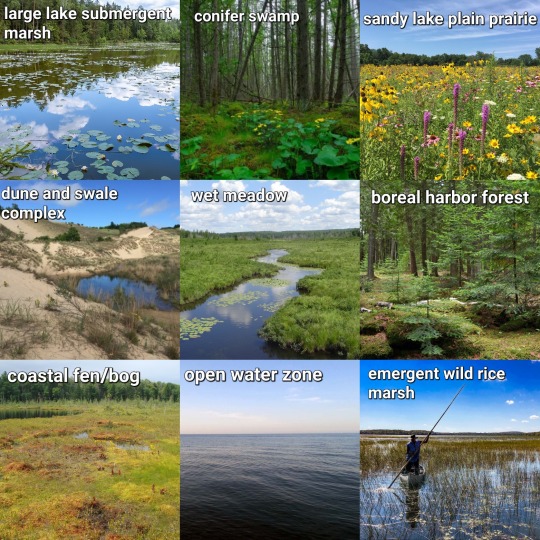
#poll#great lakes#ecosystems#ecology#marsh#lake#lakeposting#freshwater#wetlands#fen#bog#cattail#wild rice#forest#boreal#boreal forest#prairie#dune#dunes#dune and swale#estuary#delta#wet meadow#swamp
3K notes
·
View notes
Text
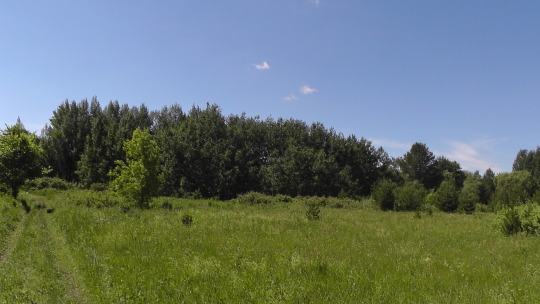



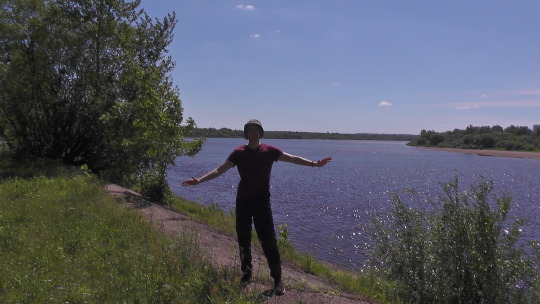
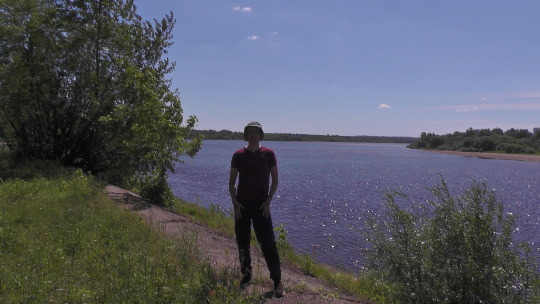




Big Vyatka Trail. Ecological route, Russia
18 notes
·
View notes
Photo


I want to let everyone know that work from my Land Studies series has been included in a new book by the talented folks at Another Earth.
What Makes a Lake? Tracing Movement brings together the work of more than 80 artists to create a portrait of Earth’ lakes, rivers, and oceans. This collection of images and text offers an intimate experience of places that we hope create a new connection to and commitment for caring for our most vulnerable ecosystems. In exploring an expanded scope of lakes around many different communities, we see how all these bodies of water are not isolated but rather flowing in and out of one another, reminding us how much our impact ripples out. What changes can be made with new awareness?
What Makes a Lake? Tracing Movement is beautifully designed and printed and is now available for pre-sale, so you can order on the Another Earth website: https://another-earth.com/books.
Curated and Edited by Abbey Meaker, Estefania Puerta and Cristian Ordóñez.
Book design by Cristian Ordóñez and Abbey Meaker.
This publication was supported by the Burlington City Arts Community Fund Grant.
#What Makes a Lake?#Photobooks#Photography Books#Publishing#Another Earth#Landscape Photography#Art Books#Ecology#Enviornmental#Lakes#Rivers#Slough#Columbia River#Columbia Slough#Pacific North West#PNW#PDX#Portland
74 notes
·
View notes